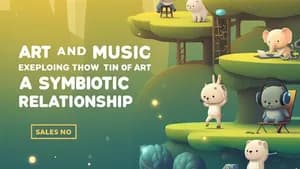Introduction: A Symphony of Influences
Have you ever noticed how certain artistic movements seem to echo the musical styles of their time? It's not a coincidence. Throughout history, art and music have engaged in a fascinating dance of mutual influence, mirroring societal shifts, technological advancements, and evolving aesthetics. This article explores this captivating interplay, revealing how innovations in one field often sparked parallel developments in the other. We'll journey through history, examining specific examples to illustrate this powerful connection, providing you with insights and tools to deepen your understanding and appreciation of both art and music.
The Renaissance: Rebirth in Art and Music
The Renaissance, a period of immense cultural rebirth in Europe, witnessed a parallel flourishing in both the visual arts and music. Think of the balanced compositions of Renaissance paintings, with their emphasis on perspective, symmetry, and idealized human forms – masters like Leonardo da Vinci and Raphael. This same sense of order and harmony is mirrored in the music of the era, particularly in the works of Josquin des Prez and Giovanni Pierluigi da Palestrina. Their polyphonic compositions, with their intricate interwoven melodies, reflect the Renaissance emphasis on structure, intellectual rigor, and the pursuit of beauty through careful craftsmanship. To appreciate this connection, consider actively listening to Palestrina's masses while studying Renaissance paintings. Note the similarities in the sense of balance, precision, and emotional restraint. For a deeper dive, research the musical scores and analyze how the counterpoint mirrors the layered perspectives in paintings like Raphael's 'School of Athens'.
The Baroque: Drama and Ornamentation
Moving into the Baroque period (roughly 1600-1750), we see a dramatic shift in both art and music. Baroque paintings, exemplified by the works of Caravaggio, Rembrandt, and Rubens, are characterized by intense emotion, dramatic use of light and shadow (chiaroscuro), and opulent detail. This exuberance and dynamism find a direct parallel in the Baroque musical style. Think of the grandeur and emotional depth of Bach's organ works, the dynamic contrasts in Vivaldi's concertos, and the ornate detail in the operas of Handel. For your study, compare and contrast the use of light and shadow in a Caravaggio painting with the dramatic shifts in dynamics and tempo in a Bach concerto. Consider how both use embellishment and ornamentation to create emotional intensity. Try creating a visual representation of a musical piece using the principles of Baroque art, or vice versa. This hands-on exercise will solidify your understanding of the shared characteristics.
The Romantic Era: Emotion and Individuality
The Romantic era (roughly 1780-1890) marked a significant departure from the classical emphasis on order and reason. In art, we see a move toward expressing intense emotions, individual experiences, and the power of nature. Think of the dramatic landscapes of Caspar David Friedrich, the emotional intensity of Eugène Delacroix's paintings, and the expressive brushstrokes of the Impressionists. Music of the Romantic period, represented by composers like Beethoven, Chopin, and Wagner, shares these same characteristics. Beethoven's symphonies, with their powerful emotional range, Chopin's melancholic nocturnes, and Wagner's sweeping operas all capture the spirit of Romanticism. To engage deeply with this connection, consider analyzing a Romantic painting alongside a musical piece from the same period. Pay close attention to the emotional palette, the use of color in the painting mirroring the emotional range in the music. This comparative study will deepen your understanding of the shared artistic language of the era.
Modernism and Beyond: Experimentation and Abstraction
Modernism in both art and music (roughly late 19th and 20th centuries) was characterized by a rejection of traditional forms and conventions. Artists like Picasso, Matisse, and Kandinsky experimented with abstraction, cubism, and surrealism, challenging traditional notions of representation. Similarly, composers like Stravinsky, Schoenberg, and Debussy pushed the boundaries of musical language, experimenting with atonality, dissonance, and new compositional techniques. For example, compare the fragmented forms of Picasso's Cubist paintings with the fragmented melodies and harmonies of Stravinsky's 'Rite of Spring'. Observe how both use jarring juxtapositions to challenge the audience's expectations and create a sense of unease or novelty. This comparison helps to demonstrate the shared spirit of experimentation and the move away from traditional structures found in both art and music during this period. Consider creating a visual representation of atonal music, using colors and shapes to represent dissonant sounds and their interactions.
Conclusion: A Continuing Conversation
Throughout history, art and music have engaged in a continuous dialogue, influencing and enriching each other. By exploring these parallel movements, you gain a deeper appreciation for the cultural forces shaping artistic creation and the interconnectedness of different creative expressions. By actively comparing and contrasting works from different eras and movements, you develop a more sophisticated and nuanced understanding of both art history and music history, enriching your overall appreciation for the power of human creativity.

